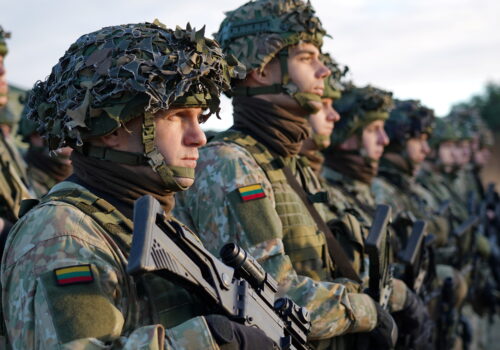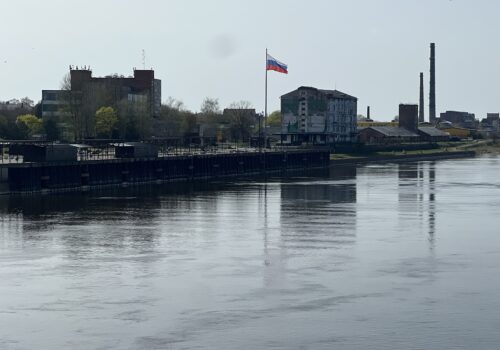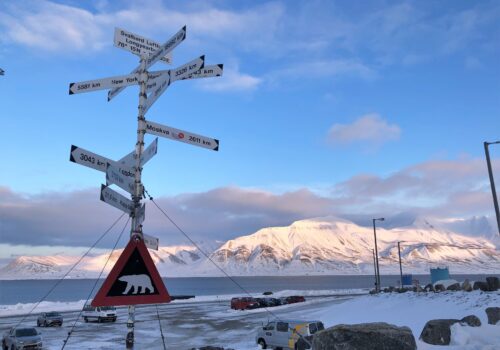Dispatch from the Russian border: The Curonian Spit and the contest of the Baltic Sea
NIDA, LITHUANIA—Few places in Europe showcase the stark contrasts of today’s security environment as vividly as the Curonian Spit, the narrow strip of land stretching from Lithuania’s coast to Russia’s Kaliningrad region. A UNESCO World Heritage site, it is known for its serene and windswept dunes, whispering pine forests, and the gentle rhythm of the Baltic Sea on one side and the Curonian Lagoon on the other. In Nida, the southernmost Lithuanian town on the spit, visitors can still feel the sense of solitude and quiet inspiration that drew German novelist Thomas Mann to build a summer house here and work on his novel Joseph and His Brothers, surrounded by sweeping vistas of sand and water.
But a short walk up the dunes—through what locals call the Valley of Silence, or more ominously, the Valley of Death—reveals a very different horizon. To the south, across a narrow stretch of the lagoon, lies the heavily militarized Russian exclave of Kaliningrad. From the Lithuanian side, Russian radar and signal loom faintly in the distance. The contrast is striking: one world rooted in Europe’s cultural and natural heritage, the other steeped in coercive posture.

Pipelines and warships
The view from the dunes of Nida reveals more than a symbolic divide, however. It highlights a region in which geopolitical friction and military pressure unfold in close quarters.
The Baltic Sea, long treated as a peripheral theater, has become one of Europe’s most contested maritime zones. Beneath its surface lies a complex network of pipelines and cables that carry power and data across the continent—infrastructure repeatedly targeted or threatened by Russian sabotage and covert operations. The suspected involvement of Russian-linked vessels in damaging vital subsea lines has rattled not only frontline states but also NATO, prompting a sharp increase in naval presence in the Baltics.
Allied surveillance flights now crisscross the region with new urgency, while frigates and naval drones roam the Baltic Sea under the Baltic Sentry mission. In June, NATO’s annual BALTOPS exercise brought together forty ships, twenty-five aircraft, and nearly nine thousand personnel to rehearse joint maritime operations along what is increasingly seen as a strategic fault line.
On the other side, Russia’s Baltic fleet—based in Baltiysk (a town in Kaliningrad) and in Kronstadt (a town that sits in the Gulf of Finland near St. Petersburg)—gives Moscow a strategic position near NATO’s eastern flank. Folded into Russia’s newly reconstituted Leningrad Military District, the fleet serves both as a conventional naval force and a launch platform for hybrid warfare.
Parades canceled, signals sent
While this aggressive posture is meant to project strength, it cannot fully conceal the vulnerabilities of the Russian Navy. Following setbacks in the Black Sea and the broader war in Ukraine, the Baltic fleet is showing signs of strain.
This was also evident during this year’s Russian Navy Day, which traditionally falls on the last Sunday in July. For the first time since its inception in 2017, the centerpiece naval parade in St. Petersburg and a smaller parade in Kaliningrad—both long seen as showcases of Russian maritime power—were canceled over security concerns.
Officially attributed to precautionary measures, the cancellation came after a wave of Ukrainian drone attacks near St. Petersburg and reflected Moscow’s growing unease about the vulnerability of its high-profile military assets.
Russia’s Black Sea Fleet has suffered repeated humiliations at the hands of Ukrainian sea drones and long-range strikes, culminating in the sinking of Russia’s flagship missile cruiser, the Moskva. The success of Ukraine’s recent “Spiderweb” operation—a long-range, multi-front drone campaign that targeted Russia’s strategic bomber bases deep inside its territory—further cemented the idea that cost-effective Ukrainian drone systems, coupled with covert tactics, can increasingly inflict damage on Russian legacy platforms once considered untouchable.
Thus, during this year’s Navy Day, Russian President Vladimir Putin, too, was largely absent from the downsized celebratory events. He addressed the fleet via video from a remote command post, observing what the Kremlin described as a combat-ready posture: a five-day military maneuver involving fifteen thousand personnel and nearly three hundred ships and aircraft across the Baltic Sea, Arctic, Pacific, and Caspian theaters. Putin used the occasion to announce a structural reform of the Russian Navy: By year’s end, two marine brigades are planned to be upgraded to divisions, with three more to follow.
Warfare without firing a shot
Yet even as Putin talks of naval upgrades and the revival of Russia’s conventional maritime might, modern conflict—particularly in the Baltic Sea—is unmistakably turning asymmetric.
In recent years, the Baltic states have found themselves on the frontlines of this more ambiguous kind of warfare, which includes Global Positioning System (GPS) jamming, spoofing, and electronic interference. These operations, widely believed to be carried out by Russian military units in Kaliningrad, have become a constant part of the regional security landscape. Their aim is to blur the lines of peace and create instability just below the threshold that would trigger a military response.
The effects are increasingly tangible along the Lithuanian coast. Commercial aircraft approaching or departing airports in Lithuania, Latvia, and Estonia have experienced growing numbers of GPS signal disruptions, forcing rerouting and raising safety concerns.
In a recent incident, German tourists flying a recreational aircraft over Lithuania’s Curonian Spit reportedly strayed into Russian airspace, likely due to GPS signal disruptions. Although the situation was resolved without escalation, it highlighted how even civilian activities in the region can be affected by the increasingly complex security environment, driven by deniable interference.
Resilience as a strategic capability
For Lithuania and its regional partners, the current challenge in the Baltic Sea is to navigate a security environment characterized by sustained, low-intensity coercion. Russia’s growing reliance on asymmetric tools reflects a calculated strategy aimed at creating friction, probing vulnerabilities, and undermining situational awareness.
The necessary response to such tactics is resilience. But resilience is not merely a fallback; it is a deliberate strategic capability. It is the ability to absorb shocks, operate amid uncertainty, and sustain effective decision-making even when critical systems are compromised or under strain.
Meeting this challenge demands several decisive steps by the Baltic nations, their regional partners, and, to a great extent, private companies operating in the Baltic Sea region.
First, redundancy and survivability must be fortified across navigation, communication, and sensing systems—leveraging tools such as multi-band global navigation satellite systems, backup solutions, and resilient civilian infrastructure. This would ensure that military and civilian vessels, aircraft, and infrastructure can continue operating amid electronic interference or major sabotage events targeting several units of critical infrastructure at once.
Second, civil-military integration must be deepened to ensure shared situational awareness and coordinated responses in electronically contested environments, particularly in the management of airspace and maritime traffic. This includes improved real-time data sharing between armed forces and civilian agencies to rapidly assess and coordinate responses to hostile asymmetric measures.
Third, attribution mechanisms need to be advanced to reliably detect hostile electronic activity and enable proportionate responses through legal, diplomatic, or regulatory channels. This could mean establishing a regional attribution and analysis center that consolidates intelligence, satellite data, and civilian reporting to detect, trace, and legally attribute a wide range of hostile activities, at the same time allowing governments to better coordinate on countermeasures.
While Russia’s asymmetric tactics represent a calculated effort to impose costs in arenas where conventional confrontation is untenable, countering them requires more than deterrence. It demands resilient institutions capable of absorbing shocks, societies prepared to endure ambiguity, and systems designed to function under persistent strain. Seen in this light, the Curonian Spit emerges not just as a symbolic divide but also as a vivid reflection of Europe’s complex and enduring security challenges.
Justina Budginaite-Froehly is a nonresident senior fellow with the Atlantic Council’s Europe Center and Transatlantic Security Initiative within the Scowcroft Center for Strategy and Security. She previously worked at the Ministry of Defense of the Republic of Lithuania in the Defense Policy Planning Department.
Further reading
Thu, Apr 24, 2025
Dispatch from Vilnius: A NATO ally in Russia’s shadow won’t let history repeat itself
New Atlanticist By James Hursch
The United States is urging its allies to strengthen their own defenses. To ensure it is never again dominated by Moscow, Lithuania is doing just that.
Thu, Apr 24, 2025
Dispatch from the Kaliningrad border: Russia is fighting a long battle of attrition with the West
New Atlanticist By Tressa Guenov
Russia has repeatedly shown itself to be a threat to its neighbors and hostile to their ambitions for closer ties with the United States and the rest of Europe.
Wed, Jul 9, 2025
Dispatch from Svalbard: Tensions are simmering in the High North
New Atlanticist By Tressa Guenov, Ian Brzezinski
A recent visit to the Norwegian archipelago revealed just how active Russia and China are in the High North.
Image: The coastline near Nida, Lithuania. Credit: Justina Budginaite-Froehly, 2025.



